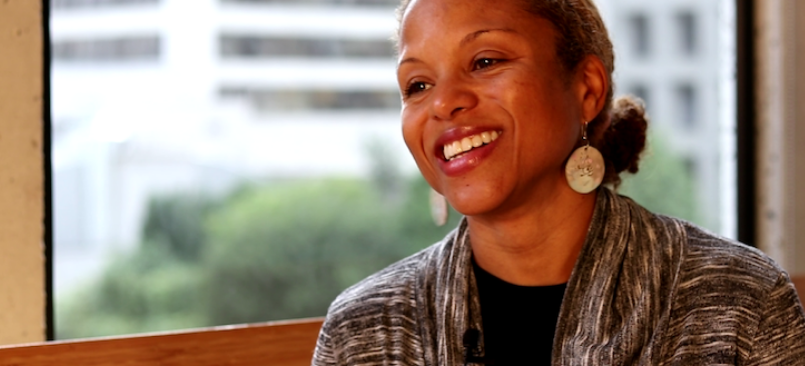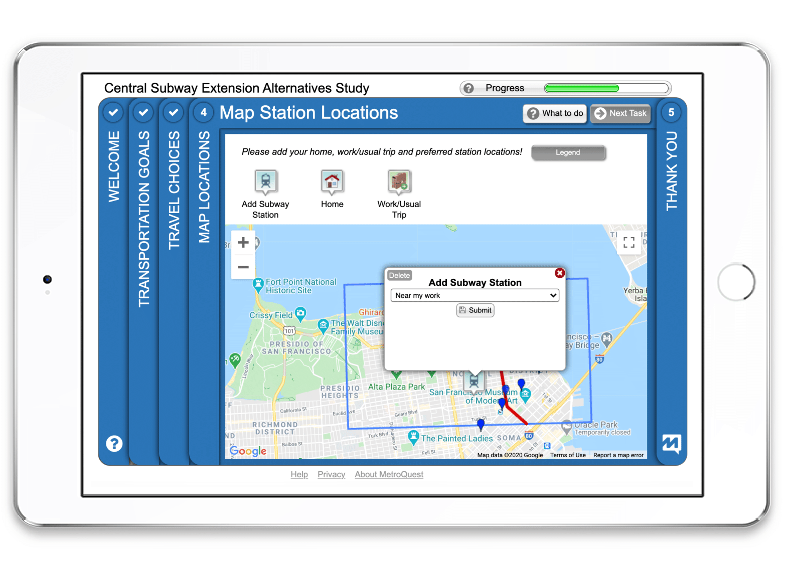An Interview with Adrienne Heim: Engagement Strategies, Tips and Techniques to Help Enhance Your Public Outreach

You may have heard the team at MetroQuest boasting about the San Francisco Municipal Transportation Agency’s (SFMTA) public engagement success before; we can’t stop talking about their remarkable outreach efforts and outstanding engagement results!
I recently had the pleasure of speaking with Adrienne Heim, the Public Information Officer for the agency’s Communications and Marketing Division. During our discussion, we talked about some of the strategies her team used to engage the collective voices of their community and gather input from over 8,000 citizens online for their Central Subway Extension Alternatives Study!
Today, I am excited to give you an inside scoop and reveal some of the strategies the agency used to achieve this remarkable level of online engagement. Read on as I uncover some of the insights Adrienne shared with me during our discussion.
Can you provide me with a quick overview of SFMTA?
The SFMTA is a municipal transportation agency that is responsible for the management of all ground transportation in San Francisco and has oversight over public transit (Muni), as well as bicycling, paratransit, parking, traffic, walking and taxis. We serve San Francisco by creating transportation options that are constant, practical and everywhere; we connect people with their community to enhance the economy, environment and quality of life.
I work specifically in the Communications and Marketing Division, which is responsible for both internal and external communications that engage and share information with customers, stakeholders, and the public. We oversee things like media and public relations, marketing and special events. We also have a distinct public outreach and engagement team that oversees stakeholder engagement and community outreach activities.
What community engagement challenges was the agency facing prior to switching your public outreach efforts online?
About 5 years ago, we used mostly text-based surveys and online platforms like SurveyGizmo to facilitate our community outreach. Our online platforms were fairly static and really content heavy. We knew we needed a solution that would help participants really get into that decision-making space and provide our team with more direct input so we could make decisions that really reflect what the community needs.
Our Division’s public outreach and engagement team has to develop a detailed communications plan which includes the tactics they intend to use to solicit community input.
“When developing the plan for our Subway Extension Alternatives Study, we discovered MetroQuest and knew we wanted to use it specifically for this project.”
MetroQuest’s map marker screen is something that really stood out to us because it enables participants to pinpoint exactly where they want a subway station as well as their final destination and spots they stop at along the way.
“We knew this mature and engaging platform would help us get feedback from more folks and give our team clear insight into what the community envisions for our subway system moving forward.”
You used MetroQuest for the Central Subway Study to achieve great success, engaging over 8,000 participants. Can you tell us about some of the tactics your team used to achieve such incredible results?
We leveraged social media to help drive traffic to the survey and increase our online participation. We also sent out email blasts with a direct link to the survey and made use of both internal and external blog posts. Leveraging the City’s online portal, we also made project announcements in newspapers and connected with the Board of Supervisors who added the survey link into their newsletters.
We also targeted Muni customers who utilize the bus routes that travel through the Central Subway Extension study area through social media posts to encourage them to participate. This helped us gather input from those that use the City’s transit lines most.
“These tactics helped us reach the individuals who don’t usually attend workshops or monthly neighborhood meetings. While having a physical presence is important, our social media efforts really helped us increase our engagement”
What are some of your top tips for agencies and firms looking to reach their target demographics?
Given the restrictions on public gatherings due to COVID-19, many government entities have had to lean towards more virtual spaces. As a result, I recommend finding out what’s working in your community and especially in specific neighborhoods since many residents’ respondent to certain types of virtual (e.g., Facebook, Instagram, Snapchat, or Zoom) or traditional (e.g., newspaper or radio) spaces. I know that a lot of community groups are hosting online meetings right now. Leveraging signage is another great way to target specific demographics. Installing a multilingual laminated sign about an upcoming project in a distinct neighborhood can help you reach a specific group, for example.
Also, talk to your council members or Board of Supervisors and neighborhood leaders and make them aware of your project efforts. They probably have an even greater network within the community so if they champion your project, you’ll likely reach groups you might not have been able to otherwise. However, I would be seriously remiss to not emphasis that online outreach can never replace in-person engagement. That especially includes our stakeholders with low household incomes and who lack smartphones and/or internet access.
Is there any additional piece of advice you would give to other agencies that are transitioning their public engagement online?
2020 has been such a collaborative moment. We’ve been reaching out to other departments within our city family to help us pinpoint what’s working, what’s not and where we think community engagement is headed. My advice is to talk and learn from others.
“So many people are open to having discussions right now, which can help you find ways to enhance your community outreach and ease your transition to engagement online.”
Congratulations to the entire team at SFMTA and thank you Adrienne for the insight! I hope this discussion inspires you and provides you and your team with some intel into how to facilitate great community engagement.
In case you haven’t seen our case study with Adrienne, I’ll include a link to the 3-minute clip here. Adrienne and her colleague, Tracey Lin, also joined us in a webinar to celebrate some of the brilliant work by women in transit planning! I invite you to watch the on-demand recording. The webinar is packed with strategies to engage thousands online, tips for delivering comprehensive planning proposals and techniques for attaining valuable insights from a broad audience.
Celebrating Brilliant Public Engagement by Woman in Transit Planning
In this webinar, Adrienne Heim and Tracey Lin from SFMTA show us exactly how they exceeded agency expectations by engaging 8,100 residents, collecting meaningful public input to build a data-driven transit extension study!


